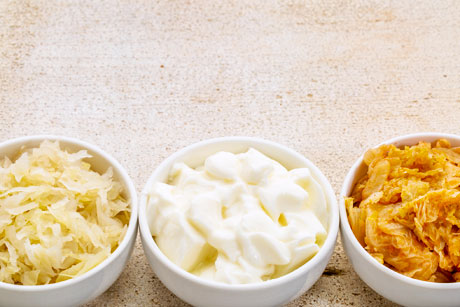
Fermentation is far from a new fad, dating back to 6000 BC; and yet, it’s at the height of popularity right now. What began as a means of food preservation has turned into a nutrition phenomenon. It often begins with a few vegetables, some water and salt or a starter. Good bacteria break down sugars in the food being fermented to create lactic acid; this kills off any bad bacteria, leaving you with a tangy, sour, delicious food product that is literally bursting with nutrition. Fermentation makes food more digestible, it enhances its protein and mineral contents and it removes anti-nutrients like lectins found in grains. Most importantly, it’s rich in probiotics, which are live microorganisms that confer health benefits on the host (i.e. you). Fermentation has powerful effects on your immune system, digestive system and even your mood.

But, there’s confusion when it comes to fermentation, so here are three things to watch out for:
1. Yogurt May Not Actually Be the Best Source of Probiotics
Canadian yogurt is made with the active bacterial cultures Streptococcus thermophilus and Lactobacillus bulgaricus, but these are actually not considered to be probiotic by Health Canada, although they do have a range of health benefits. Look out for cultures such as Lactobacillus acidophilus, Bifidobacterium bifidum, Lactobacillus johnsonii on the ingredient list to find yogurt that is probiotic-rich.
2. Pickling and Fermenting Are Not the Same
Simply because something is pickled, does not necessarily mean that it’s fermented or rich in probiotics. For a food to be fermented, it needs the presence of live bacteria that also provide health benefits. Many foods are pickled using vinegar or “quick pickled,” which doesn’t allow for this probiotic presence.
Related: Tasty Ways to Eat Fermented Food and Improve Your Gut Health
3. Not All Fermented Foods Have Probiotics
Case and point: sourdough bread. The dough is fermented by bacteria, but once heated the probiotics are eliminated. Sourdough still has wonderful health benefits, probiotics are just not one of them. Other examples are beer and wine that have undergone fermentation but no longer have probiotic bacteria.
On the flip side, here are seven probiotic-rich foods you should incorporate into your diet:
1. Kimchi
Kimchi is a traditional Korean dish composed of pickled vegetables, mainly cabbage, and spices. It’s crunchy, hot and a delicious side addition to many meals. You can buy it at the grocery store or easily make it at home.
2. Sauerkraut
Sauerkraut is another fermented cabbage dish, but this one was popularized in Eastern Europe. It’s got tons of Vitamin C and A, both important for keeping the immune system strong. Eat it as a side dish, in salads or on top of a sausage. Like kimchi, you can buy sauerkraut at the grocery store and farmers’ markets or make a batch in your kitchen.
3. Kefir
Kefir is like a yogurt drink, but it’s slightly thinner and tangier with more bacterial presence. It’s often recommended to people who have digestive issues since it’s really rich in probiotics. It also has folic acid, so it’s a fabulous beverage to incorporate into your diet if you’re pregnant. Drink it by the glass or transform it into a delicious coleslaw dressing.
4. Tempeh
Tempeh is a fermented soy cake originating from Indonesia. If you’ve never eaten it before, that description may sound odd, but it lends itself well to marinades and sauces and it makes for a fabulous mock bacon. The fermentation process not only provides probiotic richness, but it also helps eliminate phytates found in soybeans: these are anti-nutrients that bind to important minerals, like calcium, and prevent your body from absorbing them.

Get the recipe for Coconut Crusted Tempeh Skewers With Mango Salsa
5. Miso
Miso is one of the most versatile condiments: stir it into hot water to make miso soup, make it into a salad dressing, spread it over fish, chicken or cooked vegetables or even use it as an ingredient in baking cookies! It originates from Japan and is made from a combination of fermented soybeans, rice or barley.

Get the recipe for Glazed Salmon Miso Soup Rice Bowl
6. Kombucha
Kombucha is a fermented tea that is delightfully fizzy like pop. It’s brewed using a starter often called a mother or scoby (symbiotic culture of bacteria and yeasts). This naturally carbonated beverage is rich in probiotics, antioxidants and B vitamins. Find it in the fridge at your grocery store or make it yourself at home.
7. Preserved Lemons
If you’ve ever eaten a dish with preserved lemon, you know how tangy, tart and delicious they are. The really nutritious parts of lemons, such as the rind and pith (white part), are typically not eaten because of their bitterness, but after fermentation they become edible and tasty. A preserved lemon is a wonderful addition to Moroccan and Middle Eastern flavoured dishes; after fermentation, its concentration of vitamin C is heightened as well as its probiotic population.
First photo courtesy of Getty Images
